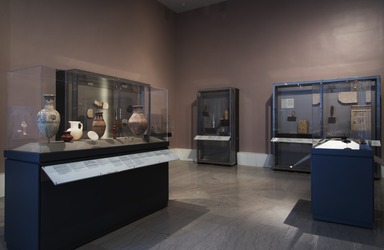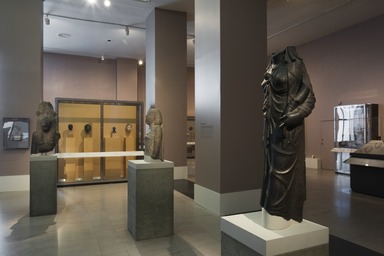

Ancient Egyptian Art, April 08, 2016 through January 31, 2018 (Image: DIG_E_2016_Ancient_Egyptian_Art_01_PS11.jpg Brooklyn Museum photograph, 2016)
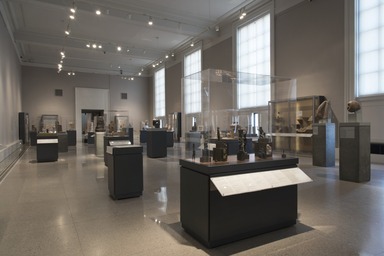
Ancient Egyptian Art, April 08, 2016 through January 31, 2018 (Image: DIG_E_2016_Ancient_Egyptian_Art_02_PS11.jpg Brooklyn Museum photograph, 2016)
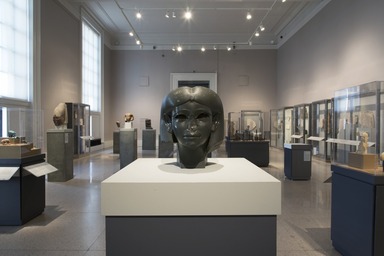
Ancient Egyptian Art, April 08, 2016 through January 31, 2018 (Image: DIG_E_2016_Ancient_Egyptian_Art_03_PS11.jpg Brooklyn Museum photograph, 2016)
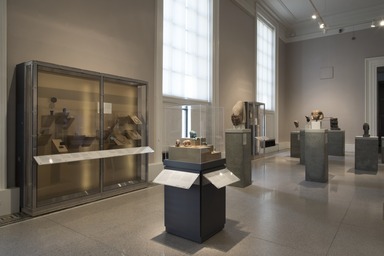
Ancient Egyptian Art, April 08, 2016 through January 31, 2018 (Image: DIG_E_2016_Ancient_Egyptian_Art_04_PS11.jpg Brooklyn Museum photograph, 2016)
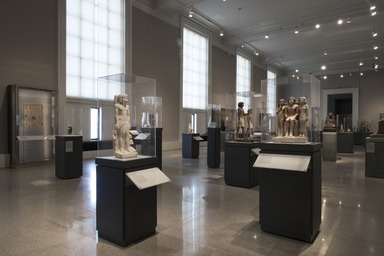
Ancient Egyptian Art, April 08, 2016 through January 31, 2018 (Image: DIG_E_2016_Ancient_Egyptian_Art_05_PS11.jpg Brooklyn Museum photograph, 2016)

Ancient Egyptian Art, April 08, 2016 through January 31, 2018 (Image: DIG_E_2016_Ancient_Egyptian_Art_06_PS11.jpg Brooklyn Museum photograph, 2016)

Ancient Egyptian Art, April 08, 2016 through January 31, 2018 (Image: DIG_E_2016_Ancient_Egyptian_Art_07_PS11.jpg Brooklyn Museum photograph, 2016)

Ancient Egyptian Art, April 08, 2016 through January 31, 2018 (Image: DIG_E_2016_Ancient_Egyptian_Art_08_PS11.jpg Brooklyn Museum photograph, 2016)

Ancient Egyptian Art, April 08, 2016 through January 31, 2018 (Image: DIG_E_2016_Ancient_Egyptian_Art_09_PS11.jpg Brooklyn Museum photograph, 2016)

Ancient Egyptian Art, April 08, 2016 through January 31, 2018 (Image: DIG_E_2016_Ancient_Egyptian_Art_10_PS11.jpg Brooklyn Museum photograph, 2016)
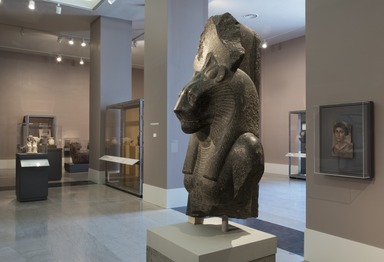
Ancient Egyptian Art, April 08, 2016 through January 31, 2018 (Image: DIG_E_2016_Ancient_Egyptian_Art_11_PS11.jpg Brooklyn Museum photograph, 2016)
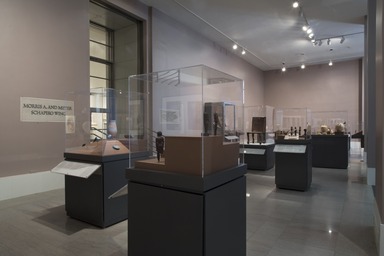
Ancient Egyptian Art, April 08, 2016 through January 31, 2018 (Image: DIG_E_2016_Ancient_Egyptian_Art_12_PS11.jpg Brooklyn Museum photograph, 2016)
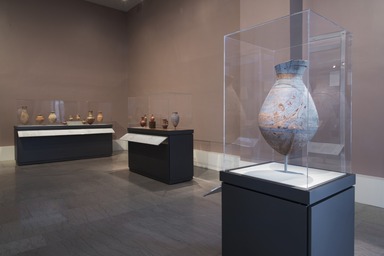
Ancient Egyptian Art, April 08, 2016 through January 31, 2018 (Image: DIG_E_2016_Ancient_Egyptian_Art_13_PS11.jpg Brooklyn Museum photograph, 2016)
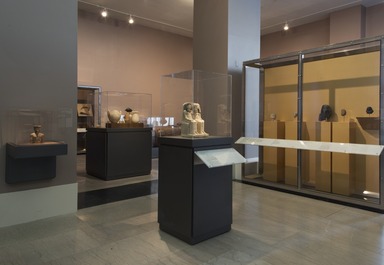
Ancient Egyptian Art, April 08, 2016 through January 31, 2018 (Image: DIG_E_2016_Ancient_Egyptian_Art_14_PS11.jpg Brooklyn Museum photograph, 2016)
Ancient Egyptian Art
-
Erotica in Ancient Egypt
Contemporary writers sometimes deny the existence of sexual images in ancient Egyptian art, insisting that erotica offended Egyptian religious sensibilities. The objects here demonstrate the fallacy of those claims. Nonetheless, what may appear to us as pure obscenity was not necessarily seen as such by the Egyptians. Humor was surely intended by some sexually laden images, and other meanings were sometimes present as well. The large group composition here, for example, has significant religious connotations such as fertility and regeneration. Beginning in Dynasty 18, sex and music were intimately connected in Egyptian art, no doubt because they were both associated with the goddess Hathor. Female musicians and dancers were often shown naked or wearing transparent garments. Occasionally they were depicted as being ravished by sexually frenzied men. In the Late and Ptolemaic Periods, small compositions with musical themes and sexual imagery became popular. All these works feature a man with an enormous phallus, sometimes with a harp on top. Sometimes, as in this case, a woman harpist faces him. -
Ancient Words
What language did the Egyptians speak, and how did they write?
Much of what we know about ancient Egypt comes from the surviving inscriptions. Ancient Egyptian belongs to the Afro-Asiatic language family, which includes African and Semitic languages spoken both in antiquity and today. It had appeared in the Nile Valley by 3200 B.C.E. and thrived until after 639 C.E., when it was gradually replaced by Arabic, the language spoken in Egypt today.
The earliest Egyptian script, called hieroglyphic, was used from about 3200 B.C.E. until 394 C.E. Scribes developed a cursive form of hieroglyphic called hieratic by 2500 B.C.E., which evolved into an even more cursive form called demotic by about 700 B.C.E. The demotic script continued to be used into Roman times (after 30 B.C.E.) until it was gradually replaced by Coptic, which employed Greek letters.
The Egyptians had great respect for education, and literacy was valued as the key to upward mobility. A Middle Kingdom text called the Papyrus Sallier 1, or “Satire of the Trades,” stresses the importance of learning. In it, a father tells his son: “I shall make you love books more than your mother, and I shall place their excellence before you.” He also describes the profession of scribe as “greater than any office.” The writer of Papyrus Sallier I advised his reader: “A scribe is the taskmaster of everyone.” -
Jewelry
Almost every Egyptian, from pharaoh to peasant, wore some kind of jewelry.
Kings and nobles owned many elaborate pieces made of gold and semiprecious stones, whereas a farmer might have a simple bracelet made of unpolished stone tied to a cord. A few specialized items, such as beaded hip girdles, were worn exclusively by women, but most jewelry was not genderspecific.
Color played a major role in jewelry design; Egyptians favored stark but harmonious color contrasts. Jewelers frequently combined gold with vibrant stones like red jasper and carnelian, green turquoise, and deep blue lapis lazuli, or mimicked these stones with glazed faience beads.
Colors also had religious significance: red alluded to blood’s life-giving qualities; green was tied to vegetation and fertility, and thus resurrection; and yellow represented gold, the eternal “flesh of the gods.” -
How Quickly Did Artistic Styles Change in Ancient Egypt?
Although Egyptian art is often thought of as static and conservative, its style underwent constant change. Styles differed between dynasties and between reigns within dynasties. Occasionally, we can even detect stylistic modifications within a single reign.
Several factors influenced changes in style. Often when a new king came to the throne, artists transformed the style that had been in vogue at the old monarch’s death. The emergence of a new Chief Royal Sculptor could also lead to alterations in style. The tendency of one generation to absorb, and react against, the teachings of its masters probably accounts for other changes.
These reliefs carved at the beginning and near the end of Akhenaten’s reign show how drastically styles could change in a single generation. The early image shows Nefertiti’s face with the same exaggerated eyes, straight nose, and full lips found on representations of Akhenaten. In contrast, the late relief portrays the queen in a softer, more subdued manner. This way of depicting Nefertiti probably reflects the emergence of a new Chief Royal Sculptor, named Thutmose. -
How Was the Egyptian Collection Assembled?
The Brooklyn Museum began collecting Egyptian antiquities in 1902, but most of the art in these three galleries arrived in New York during the nineteenth century in private collections. To them were added objects excavated by and for the Museum, as well as gifts and purchases.
The Museum’s Egyptian antiquities include three great nineteenth-century collections. The collections of Henry Abbott (1812–1859), Armand de Potter (1852–1905?), and Charles Edwin Wilbour (1833–1896) were all assembled in Egypt between 1830 and 1896, when art of the highest quality was available for sale and export from Egypt. All three collectors had excellent taste and chose their acquisitions on high aesthetic principles.
The Museum also commissioned the brothers Henri (1859–1909) and Jacques (1857–1924) de Morgan to excavate in Egypt on its behalf from 1905 to 1909, yielding one of the finest and most complete collections of Predynastic antiquities (3800–3100 B.C.E.) outside of Egypt. The best of that collection is on your left in the first gallery.
Between 1913 and 1936, the Museum participated in the excavations of the Egypt Exploration Society of London, which resulted in a fine collection of art from el-Amarna, capital of the heretic King Akhenaten (ruled 1353–1336 B.C.E.). You will find a selection of these objects on your right in the first gallery.
After 1933, an endowment gift from the heirs of Charles Edwin Wilbour allowed the Museum’s collection to grow through important purchases, including the former collection of the New-York Historical Society, which arrived in Brooklyn in 1937.
More recently, curators have paused in collecting, as legal antiquities are not readily available. Mostly, this has to do with issues of provenance. The word provenance can mean both the spot where an antiquity was excavated and, more problematically, the history of ownership of the object after its discovery. Museum labels in these galleries give the findspot of the objects.
According to the international agreement negotiated through the United Nations Educational, Scientific, and Cultural Organization (UNESCO), objects have legal ownership provenance only if they left Egypt before November 1970. The Museum is dedicated to abiding by the UNESCO agreement in its acquisitions policies. -
Who Were the Ancient Egyptians?
The ancient Egyptians were an African people who first appeared in the Nile Valley by 4500 B.C.E. and created a distinctive culture.
The Egyptians defined themselves as separate from all other peoples. They perceived their difference to lie in the singular qualities of their culture, however, rather than in physical characteristics such as skin color.
The first Egyptians came to the Nile Valley from farther south in Africa. They brought with them their language and a religion with strong, positive beliefs about life after death. In the period from 4000 to 3000 B.C.E., they were intensely creative, producing a unique civilization: they invented hieroglyphic writing, developed a system of artistic representation that communicated complex ideas, and established a political system centered on a divine king. This distinctive culture then spread from southern to northern Egypt about 3100 B.C.E. Over the next three thousand years, Nubians, Semites, Libyans, Persians, Greeks, and Romans came to Egypt. All of these groups adopted and contributed to Egyptian culture.
Nubia (modern Sudan), Egypt’s nearest neighbor in Africa, was different from Egypt in its language and way of life, though many Nubians assimilated into Egyptian culture and thus became Egyptian. Egyptians of Nubian origin fully participated in Egyptian society at all levels. They were kings and queens, high officials, priests, and peasants. But Egyptians nonetheless regarded Nubians still living in the area south of Egypt as foreign enemies no different from other foreigners. -
Why Are the Noses Broken?
The noses on many ancient Egyptian statues were broken in antiquity to deprive the figures of their power.
Ancient statues allowed supernatural beings to act in this world, giving them a physical body. People’s souls or gods’ spirits entered statues through the nose or eyes. Broken noses disabled the statue.
Statues, as well as reliefs and paintings, were primary tools for the practice of Egypt’s ancient “pagan” religion. Early Christians in Egypt defaced or destroyed these works of art as a way of attacking paganism and promoting their own religion. The biography of the Egyptian Christian Saint Shenoute (348–466 C.E.), for example, describes his attempts to eliminate paganism in Egypt by destroying statues. (Ancient pagan priests hid many of the statues that remain undamaged today.) Later, according to the Arabic chronicler Ahmad ibn ‘Ali al-Makrizi (1364–1442 C.E.), “a Sufi fanatic” named Muhammed Sa‘im al-Dahr destroyed the nose of the Great Sphinx in 1378 C.E. In modern times, the Egyptian government strives to protect the ancient monuments. -
Amunhotep III
Circa 1390–1352 B.C.E.
By associating himself with the remote past, King Amunhotep III broke with the political and military policies of his immediate predecessors.
During his reign, artists borrowed details from Old Kingdom art, carved a thousand years earlier. In addition, solar worship, which had dominated the Old Kingdom (circa 2500– 2170 B.C.E.), regained popularity.
Under Amunhotep III, Egypt became a truly cosmopolitan country with ties to kingdoms throughout Africa, western Asia, and southern Europe. Perhaps inspired by art from the ancient Near East, artists under Amunhotep III depicted the human form in an elegant, stylized manner with slanted, almond-shaped eyes, short noses, and long, dainty fingers. Women’s bodies were rendered sensuously, with physically impossible hourglass figures.
At the same time, depictions of the king show him either in a highly naturalistic manner, with swollen cheeks and a noticeable paunch, or as a god incarnate, peacefully receiving his subjects’ worship. These representations contrast with images of earlier kings that always depicted the pharaoh as a valiant warrior with a youthful face and body. -
Ancient Words
What language did the Egyptians speak, and how did they write?
Ancient Egyptian belongs to the Afro- Asiatic language family, which includes Semitic and African languages spoken both in antiquity and today. It had appeared in the Nile Valley by 3200 B.C.E. and thrived until after 639 C.E., when it was gradually replaced by Arabic, the language spoken in Egypt today.
The earliest Egyptian script, called hieroglyphic, was used from about 3200 B.C.E.until 394 C.E. Scribes developed a cursive form of hieroglyphic called hieratic by 2500 B.C.E., which evolved into an even more cursive form called demotic by about 700 B.C.E. The demotic script continued to be used into Roman times (after 30 B.C.E.) until it was gradually replaced by Coptic, which employed Greek letters.
The Egyptians had great respect for education, and literacy was valued as the key to upward mobility. A Middle Kingdom text called the Papyrus Sallier 1, or “Satire of the Trades,” stresses the importance of learning. In it, a father tells his son: “I shall make you love books more than your mother, and I shall place their excellence before you.” He also describes the profession of scribe as “greater than any office.” The writer of Papyrus Sallier I advised his reader: “A scribe is the taskmaster of everyone.” -
Multicultural Egypt
Modern Americans would recognize ancient Egypt as a multicultural society because, although Egyptians did not all share one physical appearance, they nonetheless regarded all people assimilated into the culture as true Egyptians.
The original African inhabitants who created Egyptian culture about 4500 B.C.E. were joined over the following five thousand years by other Africans from Nubia and Libya, as well as by Semites, Persians, Greeks, and Romans. These later groups often came to Egypt as conquerors. They brought with them their own social, economic, and religious practices. But in the end, these newer arrivals assimilated into Egyptian culture, in part because it offered especially attractive beliefs about the afterlife.
Although all Egyptians practiced the same religion and spoke the same language, they did not all share one appearance. To modern American eyes, many ancient Egyptians resemble African Americans, while others appear to be Mediterranean. -
Women in Ancient Egypt
Ancient Egyptian women had the same legal and economic rights as men, but their participation in public life was limited.
Marriage was a private arrangement, not documented in religious or government records. Divorce existed, but many marriages ended when a woman died in childbirth.
A married woman had the title Nebet Per, usually translated as “Mistress of the House” but actually closer to “Owner of the House.” Texts reveal that women often exercised considerable authority in the home.
Women also worked outside the home. Some women labored on farms and sold produce at market, and others wove and sold cloth. They also participated as mourners at funeral processions. Affluent women served as priestesses or, more often, as temple singers. Some royal women became quite prominent as priestesses or even as stand-ins for goddesses. But because the king was both a god and a priest, rulers theoretically had to be male. When Queen Hatshepsut assumed the kingship, she was usually represented as if she were a man.
In death, a woman had the same right to an afterlife as a man. Though women could have their own tombs, a married woman usually shared her husband’s tomb, which emphasized his public career. But even in a shared tomb, a woman always had her own coffin, shabties, and other funerary equipment; she often had her own burial chamber as well as a tomb statue or stela, or both. -
New Kingdom Grooming Articles
The ancient Egyptians believed that personal grooming was an essential part of good health and sexual attractiveness.
Men and women shaved their body hair and cut the hair on their heads very short or shaved it completely as a precaution against lice. They donned voluminous wigs to signal heightened sexual interest. Eye makeup such as kohl not only protected against sun glare—much like lampblack used by modern football players—but also emphasized the eyes’ size, shape, and natural allure. Throughout their history, the Egyptians prized richly scented ointments that kept their skin supple and slowed wrinkling. The scents of these ointments, particularly when enhanced by perfume, were considered highly erotic.
As in other Egyptian objects, the design and decoration of grooming articles often reflected religious beliefs. The most common symbols referred to rebirth and the need to control the forces of chaos that threatened to engulf the ordered universe. -
The Predynastic and Early Dynastic Periods
Circa 5000–2675 B.C.E.
Egyptian culture and the basic techniques of artistic craftsmanship took form in the Predynastic and Early Dynastic Periods, beginning two thousand years before the country was unified under a single king.
During this period, artisans worked in stone, ivory, and clay with growing technical skill. They carved fine stone vessels and cosmetic palettes, and created images of animals, abstracted human figures, plants, and boats. Decoration on pottery vessels developed from geometric patterns into increasingly elaborate scenes.
Because Egyptian writing had not yet been invented at that time, only context and later traditions can point to the meaning of many images. Objects buried in graves reveal Predynastic ideas of the afterlife, while those found in late Predynastic temples suggest a ritual function.
By the Early Dynastic Period (about 3100 B.C.E.), the land had apparently been consolidated into two centers of political control, one in Upper (or southern) Egypt and one in Lower (or northern) Egypt. Likely coinciding with further expansion of central government, such artistic trends from southern Egypt as decorated pottery and large animal sculpture spread throughout the land. This period inherited and advanced Predynastic traditions, which in turn served as precursors to pharaonic art. -
Looking at Egyptian Art
Egyptian artists communicated concise messages through the appearance of their art. Rather than portraying visual reality, however, they sought to convey political or religious ideas.
A typical relief of an Egyptian nobleman in his tomb shows the head from the side, the eye and shoulders from the front, and an unachievable twist of the torso that reveals the hips, legs, and feet from the side. While such a stance is impossible in reality, each part of the body is represented in its ideal form from the best possible angle. The artist intends to tell us through such a relief that the complete body, visible from every angle, has been reborn in the next world.
Just as this representation of the body does not match reality, so too the colors Egyptian artists used were not intended to record what a viewer would see. Thus men’s skin is painted deep red to associate the deceased with the sun-god, while women’s skin is represented as yellow, reminding the viewer of a goddess’s golden complexion. Some gods are depicted with black or green skin to communicate the idea of fertility, as with the rich, black soil of the Nile Valley or the green of vegetation. Other gods have blue hair representing lapis lazuli, a semiprecious stone whose color associated it with the heavens. -
The Old Kingdom
Dynasties 3–6, circa 2675–2170 B.C.E.
Characteristic forms of Egyptian art were developed and refined during the Old Kingdom.
At that time, artists established naturalistic anatomical proportions, as well as poses for standing and seated figures, and statue compositions of family groups. They standardized the distinctive way of depicting the human form in ancient Egyptian relief and painting—with the head and body in profile, and one eye and both shoulders shown frontally.
During the Third and Fourth Dynasties, kings and royal families were the main patrons of the arts. Largely created for their tombs, sculpture and relief represented them as idealized, broad-shouldered youths. More officials and priests decorated their tombs under the expanding governmental administration and social realm of the Fifth and Sixth Dynasties.
A new, less naturalistic style—with narrower shoulders, oversize heads, huge eyes, slim bodies, and long fingers—emerged in the Sixth Dynasty. Low harvests and the exceedingly long reign of King Pepy II at the end of this dynasty contributed to the breakdown of central government, resulting in civil unrest. The art of the subsequent First Intermediate Period (circa 2130–2008 B.C.E.) shows lower quality and provincial trends. -
The Middle Kingdom
Late Dynasty 11–Dynasty 13, circa 2008-1630 B.C.E.
While early Middle Kingdom kings continued the idealized style of the Old Kingdom (the last “Golden Age”), the Twelfth Dynasty deliberately broke with tradition, introducing expressive, portrait-like features.
Following about one hundred fifty years of social and political turmoil, King Montuhotep II reunited Egypt in the late Eleventh Dynasty. The conscious revival of such stylistic elements of the Sixth Dynasty as exaggerated eyes and elongated fingers linked Montuhotep II to earlier kings, legitimizing his role as pharaoh. Because his southern hometown of Thebes became the new capital, art of this time took on a southern flavor, notably in broader figures with full, smiling lips. As the following dynasty moved the capital north, a blend of northern and southern styles resulted in idealized figures with round faces.
In a new development of the later Twelfth Dynasty, rulers were shown with heavy-lidded eyes, facial lines, and creases. Often interpreted as literal portraiture, this apparent expressive realism more likely symbolized humanity, vigilance, or strong political ideology. During the nearly two centuries of stability in the Twelfth Dynasty, literature and the sciences flourished, while artists introduced new sculptural forms such as the block statue. A youthful, idealized look in art coincided with the dwindling royal power of the Thirteenth Dynasty. -
Hippopotami
Representations of hippos, which lived in the Nile marshes until about two hundred years ago, show how these aggressive, highly dangerous creatures constantly threatened the ancient Egyptians and their livelihood.
The earliest Egyptians recognized their destructive power and hunted hippos to guarantee their own survival. This practice continued, in ritual form, for centuries. An Old Kingdom prince had to harpoon a hippopotamus before he could be crowned king. By late in the Twelfth Dynasty in the Middle Kingdom, statuettes of hippos were included in burials in order to be killed in the afterlife. The Egyptians believed that slaughtering the malevolent beast granted the deceased immortality. -
Attributes of the Gods
The identities of Egyptian deities are often indicated in art by their attributes, such as an associated object or headdress.
A number of deities were portrayed in human form, holding specific objects. The Memphite creator-god Ptah holds a staff with hieroglyphs for life and permanence. Ptah’s son, Nefertem, a lotus on his head (symbolizing rebirth), defends Maat with his scimitar. Imhotep, the deified architect of Djoser’s pyramid, shares Ptah’s closefitting cap, and the papyrus on his lap emphasizes wisdom and creativity.
Many deities in the official Egyptian pantheon can be recognized by their headdresses. The Double Crown of the beneficent goddess Mut, whose name means “mother,” characterizes her as a conveyor of kingship and the divine mother of pharaoh. Amun, whose name means “hidden,” is portrayed as a man wearing a tall, plumed crown; when he appears with a solar disk at the base of the crown, he is known as Amun-Re, who possesses both hidden and solar creative powers. The ancient protectress Neith, associated with war and hunting, wears the flat-topped Red Crown of Lower Egypt. -
Gods in Animal Form
The animal characteristics included in portrayals of the gods were used to reveal divine qualities.
The cow or cow-human forms of Hathor refer to her role as provider of milk to Horus and to young kings of Egypt. Bastet, another benevolent female deity, appears as a cat or cat-headed woman, carrying a basket and sistrum.
In popular religion the protection of pregnancy and birth was entrusted to such deities as Taweret and Bes. The appearance of Taweret, “The Great One,” as a pregnant hippopotamus with lion and crocodile features is a dramatic symbol of protective motherhood. The dwarf with a lion’s face and legs likely represents Bes, who was worshipped in the home as a protector of motherhood, birth, and rebirth. -
Egypt and the Eastern Mediterranean
A popular misconception about ancient Egypt holds that it was an insular country that avoided contact with other cultures.
The deserts flanking the Nile Valley certainly provided formidable barriers against invasion, but throughout its history, Egyptian civilization benefited from trade and cultural exchange with neighboring kingdoms.
The earliest Egyptian commercial exchange was with Nubia to the south.
Contact with the countries in and along the Mediterranean Sea also connected Egypt to the outside world, particularly during the Middle Kingdom and early New Kingdom. Many of the objects in this case represent types that entered Egypt during that sixcentury span. The exchange of goods no doubt generated an exchange of ideas.
Although the archaeological record offers few details of intellectual dialogues, several objects displayed here provide examples of Asiatic and Aegean artistic styles and motifs on Egyptian objects, as well as a corresponding influence of Egyptian style and imagery on Mediterranean works.
Egypt constantly refined its trade policy in order to keep up with changing regional economic developments. Commerce with the Minoan civilization on Crete, for example, was particularly intense during the Middle Kingdom and Second Intermediate Period. Mycenae, on mainland Greece, traded extensively with Egypt mostly in the mid- to late Eighteenth Dynasty. -
Reliefs from the Tomb of Queen Neferu
Neferu, the chief queen of Montuhotep II, was buried in an elaborately decorated tomb near the king’s funerary temple at Deir el-Bahri.
Inscriptions in Neferu’s tomb suggest that it was finished just after Montuhotep reunified Egypt in the Eleventh Dynasty. More than five centuries later, in the Eighteenth Dynasty, Neferu’s tomb became a pilgrimage site for the ancient Egyptians. At that time, Queen Hatshepsut built her own funerary temple next to Montuhotep’s, blocking the entrance to Neferu’s tomb. In deference to the earlier woman, Hatshepsut had her builders carve a passage into the tomb, enabling Eighteenth Dynasty visitors to pay homage to an ancient queen. -
Reliefs from the Pyramid Complexes at Lisht
Amunemhat I and Senwosret I, the first two kings of the Twelfth Dynasty, hoped to glorify their reigns by linking themselves to the splendors of the Old Kingdom.
Workers for Amunemhat I dismantled several Old Kingdom royal buildings and reused their decorated reliefs for the king’s pyramid at Lisht. Artists working for Senwosret I, in contrast, simply imitated Old Kingdom style and sometimes copied even earlier models, as shown by the reliefs in this case. -
Reliefs from the Pyramid of Senwosret II at Lahun
The British Egyptologist Sir Flinders Petrie excavated the pyramid complex of Senwosret II at Lahun in 1913–14.
There he discovered thousands of limestone relief fragments covering the ground to a depth of two feet. Many of these fragments included decoration and offering texts. Petrie collected the largest, best-preserved fragments, studied them, and dispersed them to major museums around the world, including the Brooklyn Museum. -
The Early New Kingdom
Dynasty 18, circa 1539–1390 B.C.E.
Amid the extraordinary wealth and power of the New Kingdom, artists developed new styles, forms, and imagery, but still conformed to the accepted limits of artistic convention.
Following a military struggle, Theban rulers defeated the Hyksos, foreign kings who ruled the north of Egypt during the Second Intermediate Period (circa 1630–1539 B.C.E.). To commemorate the country’s reunification, art of this period revived the styles of the early Twelfth Dynasty—idealized bodies and full faces—a dynasty that had also restored stability after an earlier, troubled Intermediate Period. But early Eighteenth Dynasty artists never slavishly copied older forms, instead adding details or stylistic peculiarities unique to their own era. Such new forms as the kneeling statue were introduced at this time.
In the mid-Eighteenth Dynasty, Hatshepsut and Thutmose Ill also emphasized political and social stability through artistic continuity, refining the style known under the dynasty’s first four kings. Later Eighteenth Dynasty pharaohs, whose reigns were more militarily-minded, preferred stronger images with heavier bodies and faces dominated by straight lines that created a sense of stability and aloofness.
-
April 1, 2016
A signed, historical copy of the Emancipation Proclamation will be on view for three months as part of the American Galleries reopening
ASK, the Museum’s app, now available on Android and iPhone
The Brooklyn Museum is pleased to announce that its American and European galleries have been refreshed and reorganized, while two-thirds of its unparalleled Egyptian galleries have been reinstalled with a new thematic structure. These are the first reinstallations of the Museum’s permanent collection galleries since 2003, and they represent the first collection initiative launched under the leadership of Anne Pasternak since her appointment seven months ago as the Museum’s Shelby White and Leon Levy Director. Pasternak commented, “It’s time to revisit the Brooklyn Museum’s extraordinary collections, which span more than five thousand years of human creativity. And this is just the beginning, as Team Brooklyn Museum sets out to pursue our greatest potential and takes a fresh look at our incredible collections—while also conceiving new, special exhibitions and inciting conversations about some of the important topics in our borough, our city, and all across the globe.” The Brooklyn Museum will celebrate the reopenings at its annual fundraiser, the Brooklyn Artists Ball, on April 20.
New developments include reinstalled American art galleries that embrace a more inclusive view of history and geography, and recognize the shifting demographics of this country. Additional changes include the reorganized East Wing galleries of ancient Egyptian art, which have been restored to the original proportions designed by the architects McKim, Mead & White. While opening up new perspectives on Egypt as an African culture, the galleries will also incorporate a special contemporary art project for the first time, demonstrating the continuing importance of the ancient world to the artists of today.
At the same time, the reconfigured European gallery, housed in the Beaux-Arts Court, has been rehung thematically with works that now span a wide range of mediums, including sculpture and works on paper, in addition to painting.
Pasternak continued: “Our staff worked collaboratively to redefine our galleries so that visitors can have a fresh look at the masterpieces in our collection, seeing their own personal histories reflected in these works of art, and learning about the histories of others.”
Additionally, with support from Bloomberg Philanthropies, visitors can now experience the full interactive capabilities of the Museum’s unique ASK app, which connects visitors with art experts in real time, now available on iPhone and Android.
American Galleries
The reinstalled American art galleries (formerly called American Identities) will explore the overarching theme “What constitutes American art?,” taking a more Pan-American and cross-cultural view. The new installation, chronologically arranged, is made up of eight sections: “The Americas’ First Peoples”; “From Colonies to States”; “Imagining the New Nation’s Landscape”; “Visions and Myths of a Nation”; “Nations Divided”; “The United States on the World Stage”; “The City and the Rise of the Modern Woman”; and “Beyond Borders and Boundaries.”
In the reinstallation, the Museum is pleased to display such recent acquisitions as John Carroll, Showgirl (1929) and Daniel Cottier and Tiffany & Company, Clock (1883). Major works on view include Gilbert Stuart, George Washington (1796); Albert Bierstadt, A Storm in the Rocky Mountains, Mt. Rosalie (1866); a Maya artist’s Figure Emerging from a Waterlily (600–900); Herter Brothers, Cabinet (circa 1872); and Red River Metis or Yanktonai Sioux artist, Dress Shirt (before 1830). Curator Connie H. Choi notes, “Our presentation offers a more balanced view and tells different stories, featuring themes that address cross-cultural influences as well as historical issues of racial discrimination and urbanization. In these ways, the installation expands on questions confronting many Americans today.” Among the wide-ranging list of artists and artisans featured are John Biggers, Miguel Cabrera, William Merritt Chase, John Singleton Copley, Beauford Delaney, Thomas Eakins, Carol Emarthle-Douglas, William Glackens, Winslow Homer, Edward Hopper, Maria Martinez, Isamu Noguchi, Georgia O’Keeffe, Diego Rivera, John Singer Sargent, Florine Stettheimer, Mickalene Thomas, Tiffany & Company, and Union Porcelain Works.
Conservation efforts have made it possible for the American galleries to include such Pan-American works as Devotional Cross (19th century) from Mexico, and Carved Pilaster from Our Lady of Guadalupe (18th century) from Zuni Pueblo, New Mexico.
As part of the reopening, the Museum will display a historical, signed copy of the original Emancipation Proclamation for three months. The proclamation, first signed by Abraham Lincoln in 1863, freed all enslaved Africans in states then in rebellion, providing a legal framework for the eventual emancipation of millions of others. The official manuscript is in the National Archives in Washington. The copy, on loan from a private collector, is one of forty-eight versions, individually signed by Lincoln, in the Leland-Boker edition of 1864, sold to benefit Union soldiers who fought in the Civil War.
Ancient Egyptian Galleries
One of the most visited areas in the Brooklyn Museum, the ancient Egyptian galleries house a world-famous collection frequented by tourists, school groups, and new and returning visitors alike. The Museum began collecting Egyptian antiquities in 1902, with most of the art now in the galleries arriving in New York during the nineteenth century in private collections before their later transfer to the Museum.
Over the years, renovations in the Egyptian galleries have included a 1993 reorganization, which told the story of Egyptian art from the Amarna Period (circa 1352 B.C.E.) until the time of Roman rule (30 B.C.E.–395 C.E.). An expansion of the galleries, in April 2003, made it possible to introduce art from Egypt’s earliest known origins (circa 3500 b.c.e.) until the later Eighteenth Dynasty. The widely popular Mummy Chamber installation opened in 2010.
For the 2016 reinstallation, two-thirds of the Egyptian permanent galleries (formerly known as Egypt Reborn) will incorporate new themes that recognize the significance of African culture to the Nile Valley; the multicultural nature of Egyptian society; and its close but complex relationship with nearby Nubia. Important changes to the galleries include the removal of re-creations of Egyptian architectural elements, allowing for a newly reconfigured open floor plan. And for the first time, a contemporary art work, Lorraine O’Grady’s Miscegenated Family Album (1994), will be incorporated into these galleries, to establish a dialogue between the past and the present.
Curator Edward Bleiberg notes, “The new aesthetic of the galleries directs visitors to the art and brings out the natural beauty of the subtle Egyptian colors. The ancient artists created these works with specific light levels in mind. It is important not to set them ablaze with such dazzlingly bright spotlights as to distort their intended appearance. They are best seen, as they were meant to be, with raking light as if from a torch. This will finally be possible in our new galleries.”
In total, the ancient Egyptian galleries boast more than 1,600 objects. Significant works on view include Amunhotep III (circa 1390–1352 B.C.E.); Statuette of Ankhnesmeryre II and Her Son, Pepy II (circa 2288–2224 or 2194 B.C.E.); King as Child Protected by Goddess (circa 700–670 B.C.E.); A Prince of Tekhet (circa 1479–1400 B.C.E.); and Figure of a Bound Foreign Prisoner (circa 1979–1801 B.C.E.).
European Gallery
The European art gallery (formerly known as European Painting), housed in the Museum’s Beaux-Arts Court and its third-floor lobby, features 63 artworks, including Frans Hals, Portrait of a Man (circa 1614–15); Francisco de Goya, Portrait of Don Tadeo Bravo de Rivero (1806); Edgar Degas, Nude Woman Drying Herself (circa 1884–86); and Claude Monet, Houses of Parliament (1903). Curator Richard Aste explains, “The unifying theme here is European identity-making through the body, faith, fashion, and a shifting sense of place.” New thematic sections include “The Nude”; “The Sacred: Religious Art”; “The Secular: Portraiture”; “The Menacing Landscape”; and “The Tranquil Landscape.” And now, for the first time, works in the gallery will span all major artistic mediums represented in the collection: paintings, sculpture, and works on paper, which make up half of Brooklyn’s holdings of European art. Ten sculptures from the Museum’s collection of sixty sculptures and works on paper by Auguste Rodin will be relocated from the Entrance Pavilion to the galleries, to join the historical dialogue of the male and female form, dressed and nude, in this complete reinstallation, the first since 2003. Additional artists whose works are on view include Lucas Cranach, Gustave Courbet, Henri Fantin-Latour, Paul Gauguin, Edvard Munch, Egon Schiele, and Yves Tanguy.
Rethinking the hanging of the gallery space led to the removal of obstructive guardrails and the installation of improved lighting. Conservation support for the project made possible the reframing of the Degas and Hals paintings; the stabilizing of historical frames; the stabilization of Gauguin’s Tahitian Woman (1894) using a consolidant/adhesive; and the addition of non-reflective Optium Acrylic glazing to reduce glare, letting visitors see the works more clearly.
The Brooklyn Museum’s ASK App
This April, “ASK Brooklyn Museum”—the Museum’s pioneering app, which enables visitors to interact in real time with Museum experts—will be fully functional on both Android and iPhone. The app is funded by Bloomberg Philanthropies through its Bloomberg Connects program, a global initiative that helps cultural institutions to innovate and engage audiences through digital platforms.
Free to download on both iPhones and Androids, ASK enables visitors to pose questions about any work of art on view at the Museum and receive answers from the Audience Engagement Team in real time, providing a tailored, on-site educational experience. The app’s design is based on the look of Apple’s iMessage, to offer a simple and familiar communications interface that is both kid- and adult-friendly. Using location-aware technology, the app pinpoints the visitor’s precise whereabouts in the galleries, helping the Museum team to better answer questions and recommend other objects of interest nearby.
“ASK uses a very simple mechanism of asking a question and leverages that engagement, so we can learn more about how visitors are experiencing the Museum,” said Shelley Bernstein, Vice Director for Digital Engagement and Technology. “This is helping our curators see what’s working best and where we can make refinements for greater clarity.”
About the Brooklyn Museum
The Brooklyn Museum has long been at the forefront of engagement with underserved and younger audiences, from its widely popular Target First Saturday program and creative reinstallations of its permanent collection, to its pioneering online presence and inventive use of technology in reimagining the visitor experience. A driving force behind the massive growth and energy of the Borough of Brooklyn and of its diverse cultural community, the half a million annual visitors to the Brooklyn Museum make up one of New York’s most inclusive museum-going audiences.
With roots dating back to 1823, the Brooklyn Museum is among the oldest and largest art museums in the United States, with a collection representing nearly every culture, ranging from some of the most important ancient Egyptian works in the nation, to the arts of the Pacific Islands, Asia, Africa, the Islamic world, and Native American art, to U.S. and European art, and international contemporary works. The Museum is home to the Elizabeth A. Sackler Center for Feminist Art, the only facility of its kind in the country.
The Museum has developed a broad schedule of special exhibitions, from scholarly to popular-culture offerings. Its critically acclaimed spring 2016 season features Tom Sachs: Boombox Retrospective, 1999–2016; Disguise: Masks and Global African Art; This Place; and Agitprop! The Museum reaches audiences across the country and internationally with a robust schedule of traveling exhibitions, often drawn from its own collections, among them the current tours of Kehinde Wiley: A New Republic; Killer Heels: The Art of the High- Heeled Shoe; and Basquiat: The Unknown Notebooks. The Museum also hosts extraordinary touring shows in partnership with other world-class institutions. Upcoming exhibitions organized by the Brooklyn Museum include Who Shot Sports: A Photographic History, 1843 to the Present and Iggy Pop Life Class: A Project by Jeremy Deller.
This installation of the Brooklyn Museum’s American Art collection is organized by Connie H. Choi, Assistant Curator of American Art, with Barry R. Harwood, Curator of Decorative Arts; Nancy Rosoff, Andrew W. Mellon Curator of the Arts of the Americas; Susan Kennedy Zeller, Associate Curator of Native American Art; and Richard Aste, Curator of European Art.
Generous support for the installation of the American galleries as a part of the Brooklyn Museum’s Countdown to Launch initiatives is provided by Barbara and John Vogelstein, Dana Ben-Ari and Nikola Duravcevic, Tamara and Gregory Belinfanti, and Leslie and Alan Beller.
This installation of the Brooklyn Museum’s Ancient Egyptian Art collection is organized by Edward Bleiberg, Curator of Egyptian Art, with Yekaterina Barbash, Associate Curator of Egyptian Art.
Generous support for the installation of the Introduction and Early Egypt galleries as a part of the Brooklyn Museum’s Countdown to Launch initiatives is provided by the Elizabeth A. Sackler Museum Educational Trust, the Jerome Levy Foundation, the Frederick and Diana Elghanayan Family Foundation, and Richard A. Fazzini and Mary E. McKercher.
This installation of the Brooklyn Museum’s European Art collection is organized by Richard Aste, Curator of European Art.
Generous support for the installation of the European galleries as a part of the Brooklyn Museum’s Countdown to Launch initiatives is provided by Leslie and Alan Beller.
Press Area of Website
View Original
